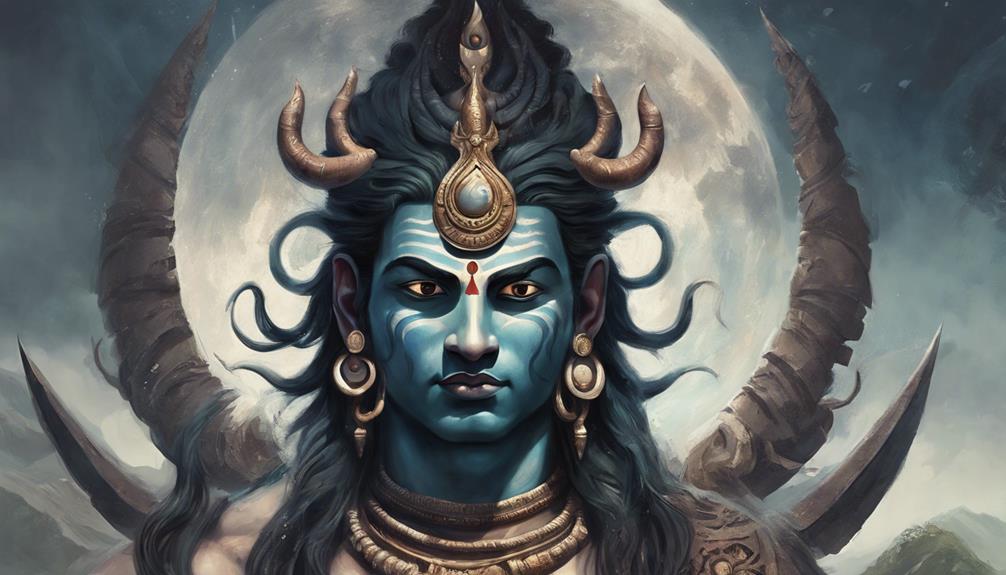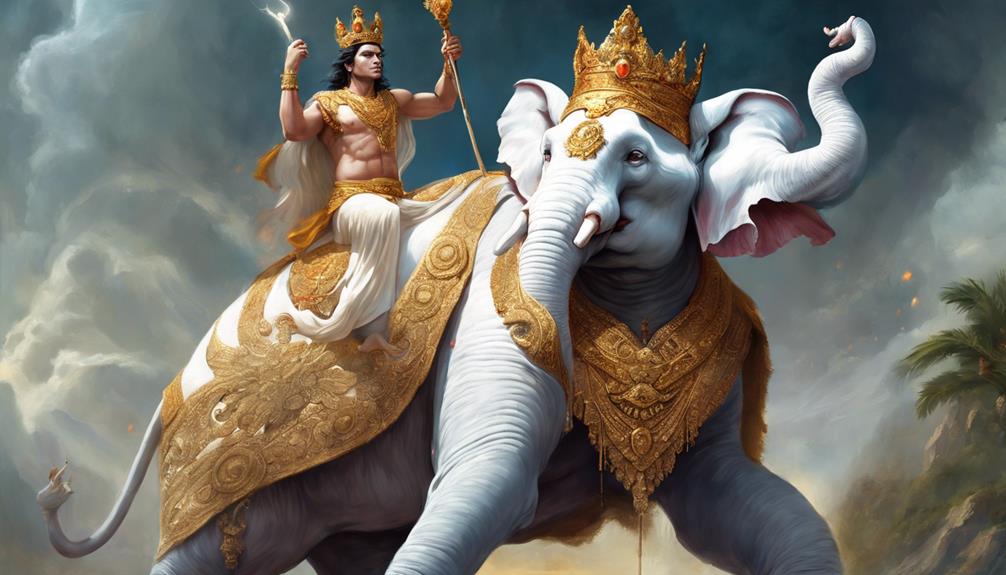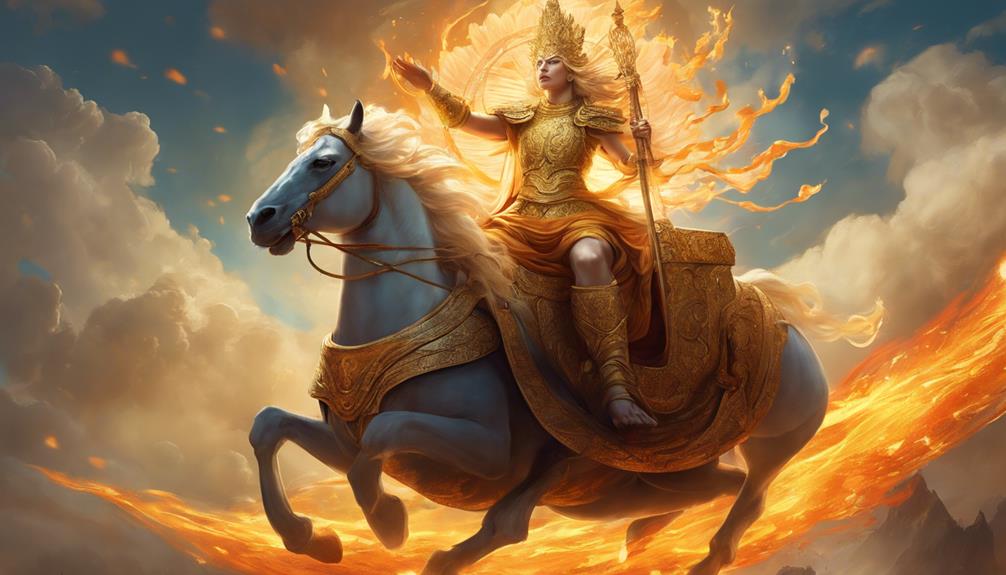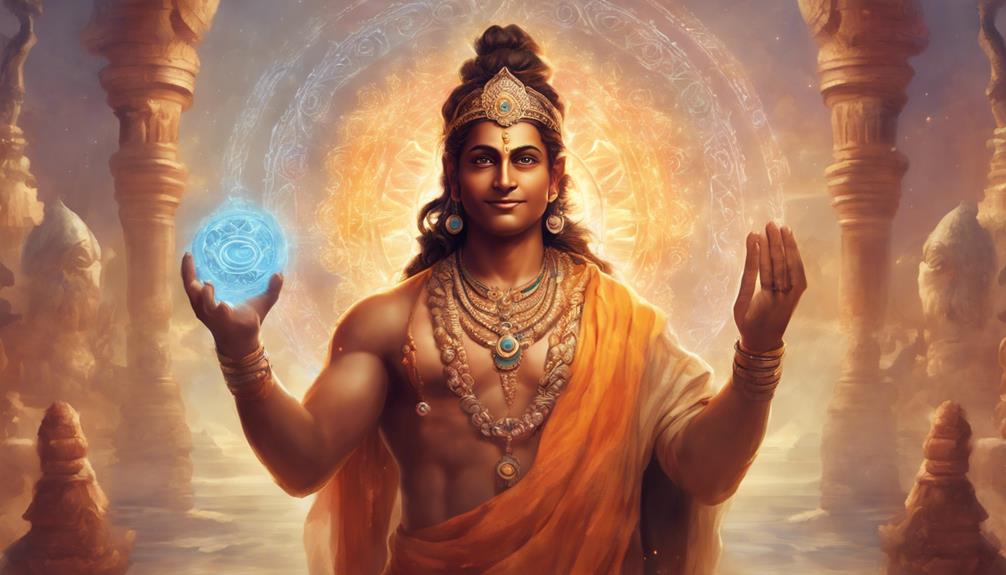In the Vedas, various Hindu gods are depicted with distinct roles and symbolism. Brahma, the creator, is symbolized with four faces representing the Vedas and initiates cosmic order. Vishnu embodies divine powers, protection, and preservation, while Shiva represents destruction and transformation through the Nataraja dance. Goddesses like Devi embody feminine energy and strength, whereas Parvati balances cosmic forces with Shiva.
Other deities like Indra, Surya, Varuna, and Mitra hold significant roles in upholding cosmic order, justice, essentiality, friendship, and social harmony. This glimpse into the Vedas reveals a rich tapestry of deities embodying various aspects of existence and cosmic balance.
Table of Contents
Key Takeaways
- Vedas describe Brahma as the creator with four faces symbolizing the Vedas.
- Vishnu embodies divine powers like protection and preservation, symbolized by a conch shell.
- Shiva represents destruction, transformation, and the cyclical nature of life.
- Devi, like Durga and Kali, embodies feminine energy, strength, and protection.
- Parvati balances cosmic forces with Shiva, symbolizing the union of masculine and feminine energies.
Deity Brahma in the Vedas
In the Vedas, the deity Brahma is described as the creator of the universe and is often depicted with four faces symbolizing the four Vedas. Brahma's creation is a crucial aspect of Hindu cosmology, where he's believed to have brought the universe into existence. While Brahma's role is that of creation, it's essential to understand that creation is just one part of the cosmic cycle in Hinduism. Vishnu's preservation and Shiva's destruction are equally essential aspects that maintain the balance of the universe.
Brahma's significance lies in his ability to initiate the cosmic order by creating the world and all its beings. This act of creation sets the stage for Vishnu's role in preserving this creation and ensuring its continuity. Without Brahma's creation, Vishnu's preservation, and Shiva's destruction, the cyclical nature of the universe would be disrupted, leading to chaos and imbalance. Each deity plays a crucial role in maintaining the cosmic order, with Brahma's creation being the foundational step in this eternal cycle.
Vishnus Attributes and Symbolism
With the focus now shifting to Vishnu's Attributes and Symbolism, exploring the characteristics and representations of this deity in Hinduism reveals a profound depth of symbolism and significance. Vishnu is one of the principal deities in Hinduism and is often depicted with several symbolic representations that embody his divine powers.
One of the most recognizable symbols associated with Vishnu is the conch shell (shankha), which symbolizes the sound of creation and is used during worship to produce sacred sounds. Additionally, Vishnu is often shown holding a discus (chakra) representing the cycle of time and cosmic order he maintains. The lotus flower (padma) is another important symbol linked to Vishnu, symbolizing purity, enlightenment, and divine beauty.
These symbolic representations not only highlight Vishnu's divine powers but also serve as visual reminders of the qualities he embodies, such as protection, preservation, and cosmic harmony.
Shiva: Roles and Significance

Shiva's embodiment of destruction and transformation in Hindu mythology holds profound significance in shaping the cosmic balance and renewal of existence. His dance, known as the Nataraja, symbolizes the rhythmic cycles of creation and destruction, highlighting the perpetual nature of the universe's evolution. The Nataraja symbolism encapsulates the idea that from destruction comes creation, emphasizing the cyclical nature of life and the interconnectedness of all things.
Shiva's relationship with his consort, Parvati, also known as Shakti, represents the union of masculine and feminine energies in the cosmos. Parvati balances Shiva's destructive tendencies with her nurturing and creative attributes, symbolizing the harmonious interplay of opposing forces necessary for cosmic equilibrium. Their partnership exemplifies the concept of complementarity and unity in diversity, showcasing the dynamic interdependence of dualistic principles in Hindu thought.
In essence, Shiva's roles as the destroyer and transformer, intertwined with his divine dance and his relationship with Parvati, underscore the intricate tapestry of Hindu cosmology, where balance, renewal, and interconnectedness reign supreme.
Devi – Goddess of Power
Embodying the essence of power and strength, Devi stands as the epitome of divine feminine energy in Hindu mythology. Devi's influence permeates various aspects of Hindu culture and spirituality, symbolizing the fierce and protective nature of the mother goddess. In Hindu mythology, Devi is depicted as the ultimate source of energy and power, often portrayed with multiple arms carrying weapons to combat evil forces and restore cosmic balance.
Goddess worship, particularly of Devi, holds a significant place in Hindu traditions. Devotees revere her through various forms such as Durga, Kali, and Parvati, each representing different facets of her power. The worship of Devi emphasizes the nurturing, protective, and transformative aspects of femininity, inspiring followers to seek inner strength and courage.
Symbolism surrounding Devi often includes motifs of courage, protection, and empowerment. Her image is adorned with symbols representing her ability to vanquish negativity and bring about auspiciousness. Devi's mythology and symbolism serve as a reminder of the eternal feminine energy that sustains and nurtures the universe.
Indra: King of Devas

Indra, known as the King of Devas, holds significant importance in Hindu mythology. His divine powers and epic battles depict him as a formidable deity within the Vedic texts.
Exploring Indra's role sheds light on the complexities of Hindu cosmology and the dynamic relationships between gods and mortals.
Indras Divine Powers
Indra's divine powers exemplify the might and authority befitting the King of Devas in Hindu mythology. The Vedas detail Indra's conquests and divine interventions, showcasing his prowess in battles against various demons and forces threatening the cosmic order.
Known for his rivalry with other deities, Indra engages in celestial battles where his thunderbolt, Vajra, symbolizes his power and dominance. Through his interventions, Indra protects the gods and maintains balance in the universe, earning reverence for his leadership and valor.
The hymns in the Vedas depict Indra as a dynamic and formidable deity, revered for his strength and strategic acumen in overcoming challenges that test the fabric of existence.
Indras Epic Battles
In the epic battles attributed to the King of Devas, Indra's valor and strategic prowess are prominently displayed, showcasing his role as a formidable warrior among the Hindu gods.
Indra's valor is celebrated in the Vedas through his numerous celestial battles against powerful adversaries such as Vritra, the dragon-like demon of drought. These tales illustrate Indra's bravery and martial skills, as he fearlessly wields his thunderbolt, Vajra, to defeat foes and uphold cosmic order.
Through his triumphs in these epic encounters, Indra symbolizes the victory of good over evil and the preservation of righteousness in the universe. The accounts of Indra's epic battles not only highlight his martial prowess but also his unwavering commitment to protecting the celestial domains from malevolent forces.
Agni, the God of Fire
The Vedic deity Agni, characterized by his association with fire, holds a prominent role in Hindu mythology and ritual practices. In Vedic literature, Agni is revered as the God of Fire, symbolizing transformation, purification, and divine energy. Fire rituals, known as Yajnas, play a vital part in Hindu worship, with Agni acting as the intermediary between humans and the gods. The sacred flames of Agni are believed to carry offerings to the divine domain, fostering communication and harmony between the earthly and celestial spheres.
Agni's significance extends beyond physical fire; he embodies the spiritual fire within individuals, representing the burning desire for enlightenment and the purification of the soul. In the Vedas, hymns dedicated to Agni praise his power, wisdom, and everlasting presence. His role as the messenger of the gods underscores his importance in facilitating communication and ensuring the continuity of cosmic order. Through the worship of Agni and the performance of fire rituals, devotees seek blessings, protection, and spiritual growth, honoring the eternal flame that illuminates the path to divine realization.
Surya: The Solar Deity

Surya, esteemed as the Solar Deity in Hindu mythology, symbolizes the radiant source of light and life that sustains the cosmos. Sun worship, an ancient practice rooted in Vedic traditions, holds Surya in high regard as the embodiment of energy and vitality. The Vedic texts describe Surya as the eye of the world, illuminating the heavens and the earth with his brilliance. Devotees offer daily prayers to Surya through the recitation of the Surya Mantra, expressing gratitude for the warmth and sustenance provided by the sun.
The practice of sun worship reflects the deep reverence ancient Hindus held for the natural elements that sustained life. Surya's chariot traversing the sky, bringing light to the world, symbolizes the cycle of life, death, and rebirth. Through the daily devotion of the Surya Mantra, followers seek blessings for health, prosperity, and enlightenment, acknowledging the crucial role of the sun in nurturing all living beings.
Varunas Cosmic Connections
With his cosmic connections transcending earthly domains, Varuna stands as a prominent deity in Hindu mythology, embodying the essence of cosmic order and universal justice. Varuna's celestial authority is reflected in his role as the god of the sky, water, and the celestial ocean. In Vedic literature, Varuna is often depicted as a stern but principled deity who maintains the cosmic order through his watchful gaze and moral judgment. His mythological connections extend to being one of the Adityas, the offspring of Aditi, symbolizing his divine lineage and connection to the heavens.
Varuna's mythological connections are deeply intertwined with his role as the god of cosmic waters and the overseer of rta, the natural order of the universe. As the guardian of moral law and cosmic order, Varuna is believed to possess the power to punish those who deviate from righteousness while also offering forgiveness to those who seek redemption. Varuna's cosmic connections highlight his significance in upholding the balance and justice in the universe, making him a revered deity in Hindu mythology.
Mitra: Vedic God of Friendship

Mitra, revered in Vedic mythology as the god of friendship, plays a significant role in the cosmic tapestry of Hindu deities. In Vedic texts, Mitra is often mentioned in conjunction with Varuna, highlighting their complementary roles in maintaining cosmic order. Mitra is described as a benevolent deity who upholds contracts, friendships, and social harmony. The concept of friendship in Vedic society wasn't merely a social construct but a divine principle embodied by Mitra.
Friendship rituals were an integral part of Vedic culture, and invoking Mitra during these rituals symbolized the importance of fostering strong social bonds. Mitra's role as the god of friendship signifies the value ancient Hindus placed on interpersonal relationships and community cohesion. By honoring Mitra in friendship rituals, individuals sought his blessings for harmonious interactions and mutual respect among friends and allies. The worship of Mitra also served as a reminder of the sacred nature of friendship and the divine interconnectedness that binds all beings together.
Frequently Asked Questions
What Is the Significance of the Number of Heads That Deity Brahma Is Depicted With in the Vedas?
The number of heads that deity Brahma is depicted with in the Vedas holds deep symbolic significance. Mythological interpretations and artistic depictions suggest the multiple heads represent his vast wisdom and ability to oversee creation.
How Do Vishnu's Attributes and Symbolism Differ From Other Hindu Gods Mentioned in the Vedas?
When exploring Vishnu's attributes and symbolism in the Vedas, you'll notice distinct characteristics setting him apart. His avatars showcase preservation and protection, while his consort Lakshmi symbolizes wealth and prosperity, distinguishing him from other Hindu gods.
Are There Any Specific Rituals or Practices Associated With Worshiping Shiva as Mentioned in the Vedas?
When worshiping Shiva as per Vedic practices, devotees follow specific rituals involving offerings, mantras, and meditation. These practices emphasize devotion, purity, and spiritual connection to Shiva, fostering a deep reverence for the deity.
How Does the Concept of Devi as the Goddess of Power Tie Into the Broader Themes of the Vedas?
In the Vedas, the concept of Devi as the goddess of power connects power dynamics and feminine energy. She embodies strength, nurturing, and creation, illustrating the balance of power and nurturing qualities essential for maintaining harmony in the universe.
What Role Does Indra, the King of Devas, Play in the Stories and Hymns of the Vedas That Sets Him Apart From Other Gods?
In the stories and hymns of the Vedas, Indra's leadership shines brightly as he stands out through his prowess in divine battles. His courage and strategic mind distinguish him among the pantheon of Hindu gods.
Conclusion
To sum up, the Vedas provide vivid descriptions of various Hindu gods, each with their own unique attributes and symbolism. From Brahma, the creator, to Vishnu, the preserver, and Shiva, the destroyer, each deity plays a significant role in the Hindu pantheon.
Devi, Indra, Agni, Surya, Varuna, and Mitra are also revered for their power, leadership, and cosmic connections. The Vedas serve as a rich source of knowledge and inspiration for understanding the diverse manifestations of Hindu gods.